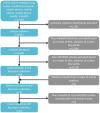mHealth for HIV Treatment & Prevention: A Systematic Review of the Literature
- PMID: 24133558
- PMCID: PMC3795408
- DOI: 10.2174/1874613620130812003
mHealth for HIV Treatment & Prevention: A Systematic Review of the Literature
Abstract
This systematic review assesses the published literature to describe the landscape of mobile health technology (mHealth) for HIV/AIDS and the evidence supporting the use of these tools to address the HIV prevention, care, and treatment cascade. The speed of innovation, broad range of initiatives and tools, and heterogeneity in reporting have made it difficult to uncover and synthesize knowledge on how mHealth tools might be effective in addressing the HIV pandemic. To do address this gap, a team of reviewers collected literature on the use of mobile technology for HIV/AIDS among health, engineering, and social science literature databases and analyzed a final set of 62 articles. Articles were systematically coded, assessed for scientific rigor, and sorted for HIV programmatic relevance. The review revealed evidence that mHealth tools support HIV programmatic priorities, including: linkage to care, retention in care, and adherence to antiretroviral treatment. In terms of technical features, mHealth tools facilitate alerts and reminders, data collection, direct voice communication, educational messaging, information on demand, and more. Studies were mostly descriptive with a growing number of quasi-experimental and experimental designs. There was a lack of evidence around the use of mHealth tools to address the needs of key populations, including pregnant mothers, sex workers, users of injection drugs, and men who have sex with men. The science and practice of mHealth for HIV are evolving rapidly, but still in their early stages. Small-scale efforts, pilot projects, and preliminary descriptive studies are advancing and there is a promising trend toward implementing mHealth innovation that is feasible and acceptable within low-resource settings, positive program outcomes, operational improvements, and rigorous study design.
Keywords: HIV Prevention; HIV Treatment; information technology; mHealth.; mobile phone.
Figures
References
-
- WHO.WHO global observatory for e-health series - New horizons for health through mobile technologies. Observatory. Geneva: WHO. 2011:3.
-
- Tudor CL, et al. van-Velthoven MHMMT. Brusamento S.; Integrating interventions for prevention of transmission of HIV from mothers to infants during pregnncy.delivery and breastfeeding with other healthcare services to increase the coverage. Cochrane Database Syst Rev. 2011;(6):CD008741. - PubMed
-
- Bailey R, Moses S, Parker C, Agot K. Male circumcision for HIV prevention in young men in Kisumu. Kenya: a randomised controlled trial. Lancet. 2007;369(9562):643–56. - PubMed
-
- Gray R, Kigozi G, Serwadda D. Male circumcision for HIV prevention in men in Rakai. Uganda: a randomised trial. . Lancet. 2007;369(9562):657–66. - PubMed
-
- Baeten J, Celum C. Antiretroviral pre-exposure prophylaxis for HIV-1 prevention among heterosexual African men and women: the Partners PrEP study IAS Conference on HIV Pathogenesis. Treatment and Prevention. Rome. 2011
LinkOut - more resources
Full Text Sources
Other Literature Sources
Miscellaneous


